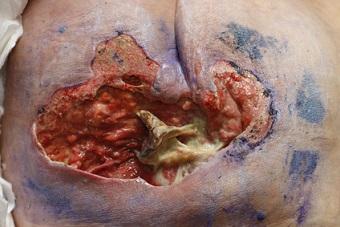Geriatric Skin Changes What is Normal and What is Not?
September 14, 2018
With a growing population of Americans aged 65 or older, it is important to know what skin changes are normal and abnormal and what we can do in terms of treatment, education, and prevention of skin injuries.
Normal and Abnormal Age-Related Skin Changes
Thin skin happens, whether it be a result of medications (anticoagulants, steroids, antibiotics, vasoconstrictors, antidepressants–to name a few), poor nutrition or dehydration, and/or age-related changes such as loss of collagen and elasticity. Because of fragile skin in our aging population, there is an elevated risk for skin tears, bruising, abrasions, and trauma wounds (from bumping into things, fall risks, etc.). See my prior post on skin tears for recommendations on interventions or prevention, treatment, and education for patients and staff.
While we are on the topic of thin or fragile skin, medical adhesive-related skin injury (MARSI) is also a problem in our older population. Because of their thin and often dry skin, along with medications they may be taking, other medical conditions, and loss of elasticity, older adults are at risk for MARSI. To learn more about management or treatment, prevention, and education of MARSI, please view my prior blog.
Dry skin happens. Skin is drier because our aging patients sometimes don't consume enough fluids or receive adequate nutrition, combined with age-related changes in the makeup of the skin itself (loss of collagen, oil glands, and elasticity) and dryness related to changes in climate (especially in the winter). The best treatment for this condition is hydration (both orally, with water and other fluids, and topically, in terms of emollients). Additionally, we should remind our patients to avoid taking baths or showers in very hot water, to avoid prolonged exposure to sunlight, and to apply sunscreen before going outside.
Incontinence isn't normal. Although functional incontinence is common (patients may have a harder time making it to the bathroom), incontinence isn't considered a normal change of aging and should be addressed on a case-by-case basis in terms of treatment, prevention, and education. Treatment options include toileting schedules, assistive devices, moisture barrier ointments and creams, containment, medical management and/or even surgical approaches, depending on goals of care, the patient's overall medical picture or status, and looking at the big picture in general. We should also continue to educate our patients on preventing skin breakdown related to moisture, calling for assistance as needed with toileting, and promoting their independence as much as able.
Age spots can happen. Usually age spots are hyperpigmented, flat, brown, tan, or darker spots that occur on the body and are related to aging. Age spots may occur on areas that were more frequently exposed to sunlight and are usually not a cause for concern. However, it is always important for us to educate our patients on preventing and recognizing the ABCDEs (asymmetry, border, color, diameter, and evolution) of skin cancer along with other more serious skin conditions. Remember, if you're ever not sure of something, your interdisciplinary team is always a great resource along with consults to specialty services as needed to help guide treatment and determine etiology.
Ecchymosis is common, especially with those patients who take anticoagulants and those who are high falls risks. Medications such as steroids (orally and topically) can also make skin more prone to injury.
Effects of Common Diseases on Aging Skin
Several medical problems also place the aging population at a higher risk for skin injuries or changes:
- Diabetes: higher risk for neuropathy, diabetic foot ulcers, impaired sensation
- Peripheral vascular disease: venous versus arterial—pain, higher risk for wounds, edema, poor perfusion
- Heart failure: higher risk for peripheral edema and blistering or wounds with impaired skin integrity
- Skin that was previously exposed to radiation: more fragile, latent effects of radiation, pain
- Moisture-associated skin damage (MASD) and incontinence-associated dermatitis (IAD): these are not normal changes of aging but are skin issues that can result from incontinence or body habitus with an inability to properly bathe or cleanse the skin and keep it clean, dry, and intact (e.g., intertrigo).
Conclusions
As we age, there are many skin changes that can and do happen, some of which are preventable and some of which are not. It is important to understand which skin changes are normal as we age and which skin changes are cause for concern or further intervention. Additionally, it is important to understand prevention, treatment, and education as they relate to our aging population and their often fragile skin.
About the Author
Holly is a board certified gerontological nurse and advanced practice wound, ostomy, and continence nurse coordinator at The Department of Veterans Affairs Medical Center in Cleveland, Ohio. She has a passion for education, teaching, and our veterans. Holly has been practicing in WOC nursing for approximately six years. She has much experience with the long-term care population and chronic wounds as well as pressure injuries, diabetic ulcers, venous and arterial wounds, surgical wounds, radiation dermatitis, and wounds requiring advanced wound therapy for healing. Holly enjoys teaching new nurses about wound care and, most importantly, pressure injury prevention. She enjoys working with each patient to come up with an individualized plan of care based on their needs and overall medical situation. She values the importance of taking an interprofessional approach with wound care and prevention overall, and involves each member of the health care team as much as possible. She also values the significance of the support of leadership within her facility and the overall impact of great teamwork for positive outcomes.
The views and opinions expressed in this blog are solely those of the author, and do not represent the views of WoundSource, HMP Global, its affiliates, or subsidiary companies.












Follow WoundSource
Tweets by WoundSource